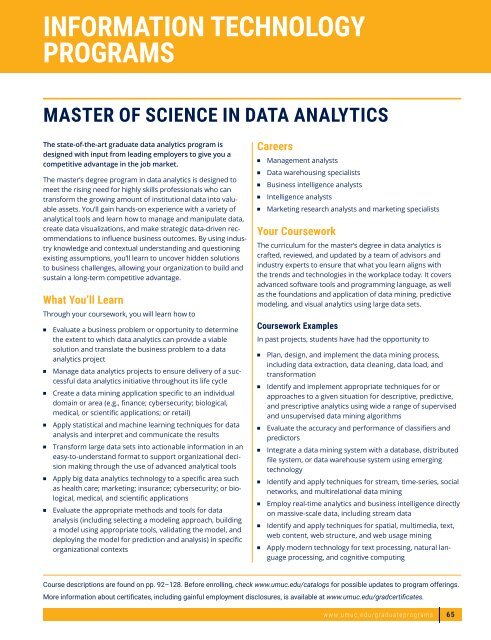2016–2017 2016–2017
2016-2017-graduate-catalog
2016-2017-graduate-catalog
Create successful ePaper yourself
Turn your PDF publications into a flip-book with our unique Google optimized e-Paper software.
INFORMATION TECHNOLOGY<br />
PROGRAMS<br />
MASTER OF SCIENCE IN DATA ANALYTICS<br />
The state-of-the-art graduate data analytics program is<br />
designed with input from leading employers to give you a<br />
competitive advantage in the job market.<br />
The master’s degree program in data analytics is designed to<br />
meet the rising need for highly skills professionals who can<br />
transform the growing amount of institutional data into valuable<br />
assets. You’ll gain hands-on experience with a variety of<br />
analytical tools and learn how to manage and manipulate data,<br />
create data visualizations, and make strategic data-driven recommendations<br />
to influence business outcomes. By using industry<br />
knowledge and contextual understanding and questioning<br />
existing assumptions, you’ll learn to uncover hidden solutions<br />
to business challenges, allowing your organization to build and<br />
sustain a long-term competitive advantage.<br />
What You’ll Learn<br />
Through your coursework, you will learn how to<br />
<br />
<br />
<br />
<br />
<br />
<br />
<br />
Evaluate a business problem or opportunity to determine<br />
the extent to which data analytics can provide a viable<br />
solution and translate the business problem to a data<br />
analytics project<br />
Manage data analytics projects to ensure delivery of a successful<br />
data analytics initiative throughout its life cycle<br />
Create a data mining application specific to an individual<br />
domain or area (e.g., finance; cybersecurity; biological,<br />
medical, or scientific applications; or retail)<br />
Apply statistical and machine learning techniques for data<br />
analysis and interpret and communicate the results<br />
Transform large data sets into actionable information in an<br />
easy-to-understand format to support organizational decision<br />
making through the use of advanced analytical tools<br />
Apply big data analytics technology to a specific area such<br />
as health care; marketing; insurance; cybersecurity; or biological,<br />
medical, and scientific applications<br />
Evaluate the appropriate methods and tools for data<br />
analysis (including selecting a modeling approach, building<br />
a model using appropriate tools, validating the model, and<br />
deploying the model for prediction and analysis) in specific<br />
organizational contexts<br />
Careers<br />
<br />
<br />
<br />
<br />
<br />
Management analysts<br />
Data warehousing specialists<br />
Business intelligence analysts<br />
Intelligence analysts<br />
Marketing research analysts and marketing specialists<br />
Your Coursework<br />
The curriculum for the master’s degree in data analytics is<br />
crafted, reviewed, and updated by a team of advisors and<br />
industry experts to ensure that what you learn aligns with<br />
the trends and technologies in the workplace today. It covers<br />
advanced software tools and programming language, as well<br />
as the foundations and application of data mining, predictive<br />
modeling, and visual analytics using large data sets.<br />
Coursework Examples<br />
In past projects, students have had the opportunity to<br />
<br />
<br />
<br />
<br />
<br />
<br />
<br />
<br />
Plan, design, and implement the data mining process,<br />
including data extraction, data cleaning, data load, and<br />
transformation<br />
Identify and implement appropriate techniques for or<br />
approaches to a given situation for descriptive, predictive,<br />
and prescriptive analytics using wide a range of supervised<br />
and unsupervised data mining algorithms<br />
Evaluate the accuracy and performance of classifiers and<br />
predictors<br />
Integrate a data mining system with a database, distributed<br />
file system, or data warehouse system using emerging<br />
technology<br />
Identify and apply techniques for stream, time-series, social<br />
networks, and multirelational data mining<br />
Employ real-time analytics and business intelligence directly<br />
on massive-scale data, including stream data<br />
Identify and apply techniques for spatial, multimedia, text,<br />
web content, web structure, and web usage mining<br />
Apply modern technology for text processing, natural language<br />
processing, and cognitive computing<br />
Course descriptions are found on pp. 92–128. Before enrolling, check www.umuc.edu/catalogs for possible updates to program offerings.<br />
More information about certificates, including gainful employment disclosures, is available at <br />
www.umuc.edu/graduateprograms 65


